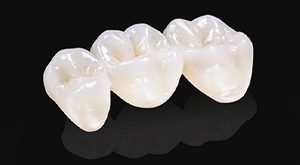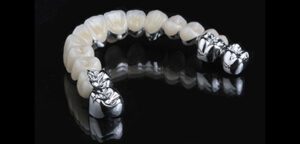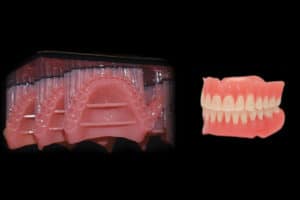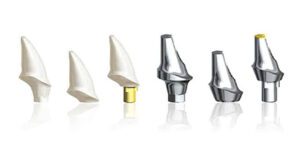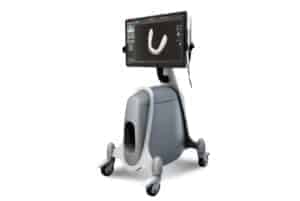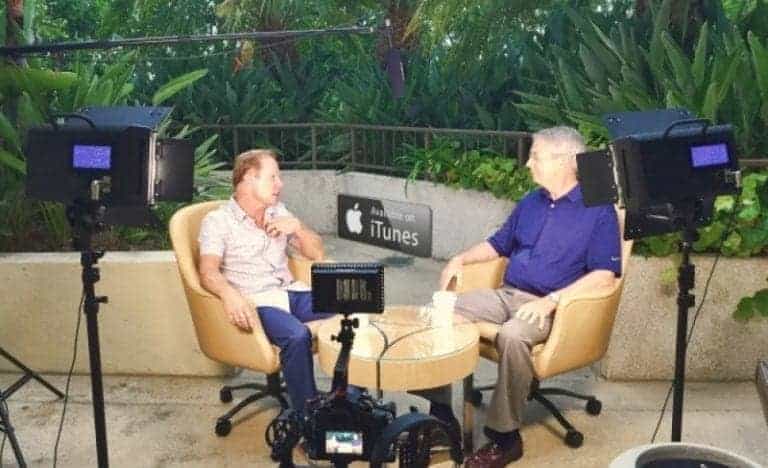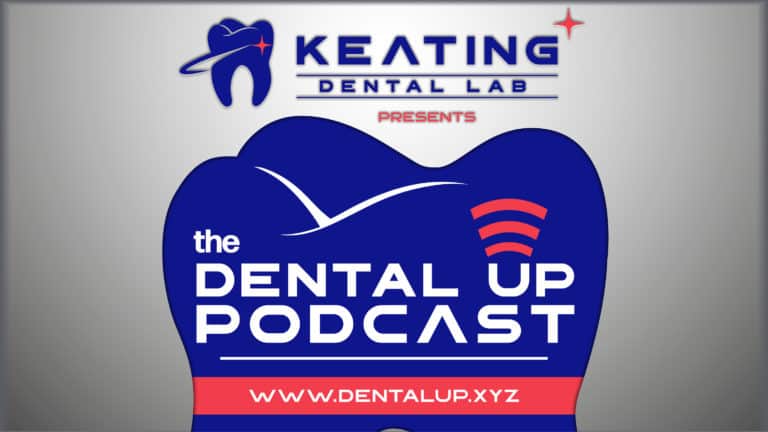Get your ‘fill’ with Dr. Ron Jackson and Dr. Hornbrook from the Kerr Convention 2015. Dr. Ron Jackson shows his passion for patient benefit through long lasting materials and ingenuity in this week’s Dental Up podcast.
Dont forget to see the full text transcript below and Subscribe to the BEST dental industry content available.
Subscribe to the Best Dental Podcast in the Industry:
Click Here: itunes.com/podcast/dentalup
Podcast Transcription:
Dr. Hornbrook: Hello. It’s Dr. David Hornbrook, the clinical director of education and technology at Keating Dental Lab in Irvine, California. Here again for our weekly podcast. Usually we’re in the studio, but we have the distinct pleasure of being at the Island Hotel. Unbelievable hotel right here on Fashion Island in Newport Beach. It’s a beautiful day like it always is in Southern California.
We have a guest, been a friend of mine for 25 years, Dr. Ron Jackson who most of you do know or have seen him lecture. If you don’t, you need to. Welcome.
Dr. Ron Jackson: Thank you, David.
Dr. Hornbrook: Have a good time.
Dr. Ron Jackson: My pleasure. Yeah.
Dr. Hornbrook: We’re talking earlier about some of the things you’re doing now and you and I go way back doing lectures together where you were the posterior guy. You were the only guy doing with concepts and then directs. We’ve had some fun doing back and forth with anterior and posterior.
Dr. Ron Jackson: Yes. Yeah, we have.
Dr. Hornbrook: I know you’re doing a lot of fun things now and one of the things obviously is SonicFill which is your baby in case our listeners and viewers don’t know that, which I’m a huge advocate of it as you know. I still practice clinically so I still use it daily as well as my associate and I know you do as well.
Dr. Ron Jackson: That is done very well.
Dr. Hornbrook: Tell us a little bit about that journey. In the late 80s, early 90s you were doing concepts and you were lecturing on concepts. Concept is an indirect resin, microfilled it. Really was way ahead of its time.
Dr. Ron Jackson: Way ahead of it’s time.
Dr. Hornbrook: I think I still have some of those that are 25 years in the mouth, it looks gorgeous.
Dr. Ron Jackson: They do. They are tremendous.
Dr. Hornbrook: Talk about your journey from there. How’d you get into that in the first place, lecturing and educating?
Dr. Ron Jackson: Lecturing education was complete accident. It was never a goal. In fact it’s the one thing I’ve done in this profession that was never established as a goal and a plan to achieve it. It basically happened.
To go back to how or to answer your questions about how I got into lecturing at all. Like you, in the early 80s, and I guess that’s why we’re both still out there talking about the topics we’re talking about, adhesion and the so-called aesthetic revolution.
When ceramic veneer was first brought out with John Calamia at New York, invented that and it got going and then Bob Nixon and everybody is teaching these things. Why doing indirect ceramics and smile makeovers and then Buddy Mopper and Norman Feigenbaum began talking about direct resins when the microfill was introduced and we could do some direct resins.
These are good complementary materials there. Once you improve somebody’s smile, they began asking about the back teeth. What are you going to do about these things? These gray things. They’re awful. We didn’t have composites. Direct composites. They weren’t very good. The old self cure, auto cure types. Paste, you stuff them in there. The particle size were like boulders, so they come plucking out. We used to call them those plucking composites and we just couldn’t do anything for them back there except crowns, and you don’t want to crown all those teeth, just because of the amalgam fillings in it. I began to fool around and look for some things and then, as you know, because you were involved very early as well, Ivoclar came out with this material, indirect resin. Heat and pressure cured, which took this composite and gave it super physical properties of fracture toughness, vital strength and wear resistant.
Dr. Hornbrook: Wear resistant.
Dr. Ron Jackson: Unbelievable. Wear resistant was just … Because it was hydrofill. I thought, well that’s just terrific. In other words, I was looking for this type of restorative method.
Dr. Hornbrook: Right.
Dr. Ron Jackson: To treat my patients. Had nothing to do with anything other than serving the patients. Got in early on that. I was like the 3rd person or so to get a system. I had the system in my office. I made them myself.
Dr. Hornbrook: Right.
Dr. Ron Jackson: Patients were ecstatic. I just kept doing it. I always photography my dentistry because I wanted to track things. To see how well they hold up over time. You can’t do it from memory. You’ve got to have pictures. I also began to realize …
Dr. Hornbrook: If we try to do it from memory, everything we’ve ever done lasted and looked good.
Dr. Ron Jackson: Right. That’s exactly right. Took pictures and I had befores and I had afters and the next thing I was talking to some dentists in my dental society, he said “Hey, we’d like to see what this is all about.” It’s just anything, so I took a handful of slides, in an informal study club without any preparation, I showed them around, they said “Wow, that looks really good. We’d like to learn how to do these things. Could you put together, you know, a technique?” Well, okay. I began to photograph that. As you know what happened, the next thing I did was, you might call it a lecture. It was very crude presentation to that group. Then another study club, then a dental society and so on and so forth. Then laboratory groups because they were, Ivoclar were selling to the labs and labs wanted their dentists to learn how to do it, so they’d sponsor lectures. Remember how we used to do a lot of lectures for laboratories?
Dr. Hornbrook: Yeah.
Dr. Ron Jackson: That was from 1986, I think, 87 when I first started. When the aesthetic revolution hit in the early 90s, everything took off from there with empress and so on and so forth. I also got really interested in … I don’t know if you know this, David, but my background is chemistry. My undergraduate major was chemistry.
Dr. Hornbrook: I didn’t know that.
Dr. Ron Jackson: I came very close to not going to dental school. I always wanted to be a dentist since age 9, but when I got in high school I loved chemistry and physics. Though, okay, I’d major in chemistry because it was my favorite subject. Then I began to think maybe I’ll stay in this. But, I changed my mind. I said “No, I’ve always wanted to be a dentist. Let me do that. If that doesn’t work out, I’ll go back into chemistry.”
Dr. Hornbrook: Right.
Dr. Ron Jackson: What’s wrong? Then, when the aesthetic revolution hit, adhesion began to change. We were again bound to dent … That’s all about chemistry. My favorite part. Organic chemistry is my favorite part of chemistry, about chemistry. That got me involved in product development. Manufactures started to … We’d come to the events that they’d put on for what they’d call KOLs, key opinion leaders. You’ve got to voice your opinion about things. Say, “We need a, we’d like to have a consultant on some products.” I did a lot of those things gratis, actually, because I didn’t know any better.
Dr. Hornbrook: We all did.
Dr. Ron Jackson: We did a lecture.
Dr. Hornbrook: I came up with this unbelievable idea, it’s going to make millions of dollars. Here. It’s yours now.
Dr. Ron Jackson: I watched a few composites. That was more my area. Become extremely successful and you’re exactly right. They were very grateful. I was happy. Well, okay. Next. Next project.
You know how life is. It builds. You’re at the right spot, right time, and Kerr gave me an invitation to participate in a revolutionary product. Not just an improve. Dentistry moves towards better and better and better. This was an opportunity to revolutionize the way things were being done and to develop a posterior composite completely different. Unique in that it is intended strictly for posterior use and it has. It’s changed …
Dr. Hornbrook: It’s a great product. For those that are listening or watching, if you don’t know what SonicFill is, I mean, be sure to look. It’s a Kerr product. It’s actually a composite. It’s in a little [inaudible 00:07:54] tip that you put on an ultrasonic hand piece, made by KaVo, because Kerr and KaVo are part of the same umbrella, the Danaher company. It’s a very stiff, packable, almost carvable composite. Almost unbelievable.
Dr. Ron Jackson: [inaudible 00:08:07] fill.
Dr. Hornbrook: You couldn’t put it in a CR syringe, you’d break the tip.
Dr. Ron Jackson: Yeah.
Dr. Hornbrook: So you put your foot on the radiostat, and this ultrasonic energy changes the consistency of the viscosity and takes this really dense, really great handling composite, makes it almost like a flowable. Your back filling, almost like doing a build up. You let it set up for 5 seconds and now you can carve or pack it in. It’s got a 5 to 6mm depth of cure, depending on what Kerr says or what other people … But I’ve never seen it less than 5, which is …
Dr. Ron Jackson: As a matter of fact, as you know, talking to Mike Totola last night, he’s now working with Gordon at CR Newsletter and what used to be called CRA. Their work showed a 9mm … I was at Mike’s house last night … A 9mm cure, which is just outrageous. What people don’t understand, and I think it’s important. This is the marriage of physics and chemistry. This was why it was so much fun doing this thing.
Let’s step back a little bit. Composites have gotten really good. The filler content. The smaller particles got smaller and smaller, down to nano now. We’re up to the 80s as far as volume, or weight percent. 70s in volume percent in these things. These products are great. We got matrixing that’s going to give us a contact, that’s as predictable as tomorrow. Our adhesives have gotten to where they’ve gotten to. But, here we are still lining. Putting in liners, curing that, putting in 2mm increments of an MOD. What are you putting in? Like 50 or something? I’m joking now, of course.
Dr. Hornbrook: At least. Right?
Dr. Ron Jackson: They’re tedious, they’re time consuming, they’re exacting. The profit goes down the more time that it takes you to do these things.
Dr. Hornbrook: Dentists also compromise. We are a profession that breeds a little bit of mediocrity, so they start doing that and say this isn’t working for me. Let’s bulk fill them.
Dr. Ron Jackson: Bulk fill it anyway.
Dr. Hornbrook: Not really designed to be bulk filled.
Dr. Ron Jackson: You get all your failures because they’re not getting fully cured. Because there’s the problem. It’s depth of cure. Shrink and stress. The bigger the bulk. It’s not really the shrink and stress. There’s a little disagreement, quite a bit of disagreement on bulk fill, whether it creates more shrink and stress or, in fact, less. [inaudible 00:10:25] did a study where a number of people found the higher the volume, the less the shrink and stress because if you do it in layers it adds up. But, the layering technique, the validity of it was because we couldn’t cure more than 2mm.
Dr. Hornbrook: Right. The depth of cure.
Dr. Ron Jackson: You got a big hummer of an MOD, you’re going to put in multiple layers. It’s taking your time. It’s taking you effort. It’s exacting because if you leave any gaps anywhere, then you’ve got problems. Like you said. Dentists are under time pressures and the practice dentists told me and I’m sure they’ve told you this, Pauly doesn’t know this, but I’ve had some dentists say “I can’t do an MOD composite and make a living. I’ll crown that tooth.” Even you can understand. The insurance reimbursement is now where near enough for given the extra time and effort that it takes compared to an amalgam. But, dentists’ patients don’t want amalgams anymore. You getting too [inaudible 00:11:20].
Anyway, back to the story. The question is what we in the profession needed. Because all the other parts were there. Was a faster, easier way of placing these things as your bulk fill market. Now, the bulk fill market, in order to get there, manufacturers had to develop higher depth of cures. In some cases that was development of a new photo-initiator to add to it. Others it was making it more translucent so you could get better depth of cure. Then they split in 2 directions. One all basically use a flowable base, which was totally transparent and clear, but had a 4mm depth of cure, so you fill up 4mms of flowable material, but since that can’t tolerate [inaudible 00:12:08] forces and you can’t sculpt it or anything like that, then you put your traditional composite on top. That works. That’s definitely a short cut. That definitely works. The science shows that.
The other path was to develop the high viscosity material. The problem with a very high viscosity material is it doesn’t adapt well. You put your liner, your typical liner, then you adapt that. That works very well. As you know, as you just described what SonicFill does using sonic energy, high frequency vibration with real logic modifiers, that’s where one of the patents is, with real logic modifiers. When you hit that with high frequency vibration of a given amplitude and frequency, it drops the viscosity about 87%. Almost to a flowable.
But, there’s another factor going on. It’s not only going in as a flowable, it’s vibrating. Stop and think about this. How do we pour impressions?
Dr. Hornbrook: We bite down on the stone.
Dr. Ron Jackson: We put our impression on a vibrator and we vibrate the stone on there. Why do we vibrate the stone? To get total adaptation.
Dr. Hornbrook: Right.
Dr. Ron Jackson: So not only have you got a low viscosity material going into the tooth, it’s vibrating, so it’s really becoming integrated into the surface, intimately, with the surfaces of the cavity. You won’t have voids. You’ll have higher bond strength as well, actually. There’s science on that. Then, as you said, because it’s vibrating and the physics also changes the way it cures, it actually gives it a higher depth of cure and it gives you a lower shrinkage [inaudible 00:13:45]. Because there’s a slow modulus build up. I don’t want to get too technical with science. I know that the folks will get bored. But I also know that a lot of dentists want to know how something works.
Dr. Hornbrook: Right.
Dr. Ron Jackson: When we first launched this product, most dentists, including some lecturers, known lecturers, said “This can’t work.” We’re now 4 1/2 years into it.
Dr. Hornbrook: It’s amazing.
Dr. Ron Jackson: 15 million restorations around the world. It’s growing like crazy. One thing about dentists, if something doesn’t work, they quickly realize it doesn’t work. You don’t get the growth. You don’t get that. They knew before the science. But right now, the science is coming in. I have a file I want to give you of science on bulk fills and on sonic fill, in particular, but bulk fills, because there are still dentists saying you can’t put that much in. That won’t work. Well, they all work.
Dr. Hornbrook: I agree.
Dr. Ron Jackson: All the products work. I don’t want to be too heavy on the SonicFill. From that standpoint, they all work. All SonicFill does is it leapfrogged, instead of 2, maybe even 3 increments, it fills the whole thing in about 5 seconds.
Dr. Hornbrook: Yeah.
Dr. Ron Jackson: With higher adaptation and it just shortcuts everything.
Dr. Hornbrook: You know, talking about the physics and the science, a lot of people would say “Wish this was different, this was different.” I remember, early on, I was involved with you. Sitting in a room a couple years ago and saying “Okay, Ron, this is what you need to do. You need to change the angle, or make the tip so I can move it around. You need to change the diameter of the tip.” You said “No we can’t.” All the rules changed with the physics. I’m just thinking it’s the material in there, but it’s all about the science.
Dr. Ron Jackson: It’s all about the science.
Dr. Hornbrook: The angle and …
Dr. Ron Jackson: Your help was really, really good, because we’ve known each other for so long, our thought patterns and everything, and your knowledge is so deep. I’ve always admired your work, your teaching, and working with you. You’re such an educated fellow. You gave some good information that day. That was to … That was because we were working on SonicFill2 at that stage. Your input was very valuable.
Dr. Hornbrook: That was a fun day.
Dr. Ron Jackson: It was fun. I want to thank you in front of everybody for your help on that and there were other people involved too. You’re absolutely right. You see, the tip has to be vibrating along. We can not lose any energy as it’s exciting the tip. It has to get to the tooth with it’s full energy. That interval and the diameter and the curvature, it was a fascinating project. It still is.
Dr. Hornbrook: I bet. You come up with this idea. I’m sure the idea probably wasn’t let’s put sonic energy. It was like, how can we change the viscosity only using one material.
Dr. Ron Jackson: Yes.
Dr. Hornbrook: Okay. You went to Kerr?
Dr. Ron Jackson: Actually no. It wasn’t quite that way. By the way, you may recall vibrating, way back, we used to vibrate concept inlays down using our ultrasonic, I get mine from my hygienist room. We go get the ultrasonic scaler. Put some composite, cured composite on the tip so it wouldn’t scratch it, put it on the inlay. Because we didn’t have … We didn’t [crosstalk 00:17:02]
Dr. Hornbrook: We didn’t have good ones.
Dr. Ron Jackson: We had terrible ones and it hadn’t really been evolved yet, so we used helium molar, also, in restoring a composite. Stuck it in and vibrated. The idea of vibrating and lowering viscosity, especially if you’re going to do it under pressure, is not a new one. There. Kerr was aware of that. They actually came to me. That’s how that worked. They had this idea. They had parts of this idea. When they came to me they said “We’ve got our KaVo company as a division and Kerr and we’d like to marry these companies together and develop something.” We had no idea it could be done. There are specific parameters, there’s parameters involved in this, but you have a goal. There are specific handling characteristics and performance and those are critical. That’s where they needed a dentist who’s mind has been buried in composites for 20 years. There. Actually, working with their polymer chemists and their hand piece engineers truly was a team effort. I was the dentist involved in it, but I want to give total credit to that whole team that Kerr had.
They also just said “Okay, it’s done when it’s done.” We didn’t know we could accomplish it when we started. They took a bit of a flyer. We had to really discover some things. I appreciate the opportunity they gave me. They’re a wonderful company as you know. A lot of the dental companies, the major companies, today. Good companies. Good products. Dentistry is progressing at a phenomenal rate. It’s all good for us and good for our patients.
Dr. Hornbrook: Yeah. Talking about that, progressing so rapidly. The change in the last 20 years is more than in the last 70 years before that.
Dr. Ron Jackson: Oh, yeah.
Dr. Hornbrook: More than 20 years before that. Where would you see, if I described the SonicFill in the future, not necessarily the sonic fill, but where are we restoratively. Let’s talk about directs, since that’s kind of your baby right now. Where would you see … SonicFill2 is just released. More highly polishable.
Dr. Ron Jackson: Wear resistant since SonicFill2. It’s reaching the limit now where it will probably wear less than amalgam. That’s where we are now. That’s incredible. But, the future? Well, the buzz word today in adhesive dentistry, whether it’s adhesive, it’s really restorative, oh by the way, who knows. We may end up with a self adhesive fully. We do have low viscosity self adhesive. Actually Kerr has one, Vertise Flow. But, we don’t have a self adhesive restorative. Dentists would love to skip an adhesive step because there’s many still have not gotten a total handle on it, although many have got it now and doing well with it. There’s a possibility there. I do think though bioactivity is the main buzz word. I would imagine every single company out there is working on that. You know we have a couple of bioactive materials, restorative materials, biodentine is one. There’s a few others in cements. Ceramir and BioCem is one. There are a few efforts into this bioactive field.
Bioactive, by the way, maybe we should define it. What we would like is to have a material that is antimicrobial, releases, I don’t know, whether it be chlorhexidine, choline chloride, or some sort of quat ammonium sort of thing. There’s science behind this, but if we could have something that would be antimicrobial, we wouldn’t have recurring decay, even if your margins were open. Something like a [inaudible 00:21:05] which has been the strength of those all along.
The other thing is remineralization. We need a material that will release calcium and phosphate ions in a way that we see some of the remineralization like we do with calcium silicate materials that are showing that bioactivity as well. Those are going to be … Those are challenges. Those are not going to be easy. You still have to have stability in the material. But yet, you can’t have these 2 benefits without the release of some chemistry. Without breakdown of the material.
Dr. Hornbrook: There’s still a long way for us to go.
Dr. Ron Jackson: I think so.
Dr. Hornbrook: You look at it and say “How much better can these materials be?” These are things that can make things better. It’s about lasting longer. Dentistry lasts longer patients benefit.
Dr. Ron Jackson: Exactly. We’re always looking for better things and that’s the nature of health care. That’s why we’re a science. A profession.
Dr. Hornbrook: Where are you physically now? You and I we’re always total lecturers. Where are you now? We haven’t talked about this in a while.
Dr. Ron Jackson: No, we haven’t. It’s an interesting sort of thing that we have going now. With the universals coming out, I’m still … Here again, I have to say I’m a practicing dentist 2 days a week. I’m still lecturing although my lecturing schedule is tapering down. I’m not doing the hands on courses like I used to. It’s only just because of the age factor. I have the will but … The mind is willing but the body is weak. Doing less of that. Just slowing the whole thing down. But, when it comes to adhesion, you’ve got the universal adhesive. This will just take a minute. I don’t know how much time we have. Spend time on that. Those allow you to be a total etch or a self etch.
Dr. Hornbrook: Right.
Dr. Ron Jackson: Or of course you can always select an etch. The big question, with the exception of Kerr’s OptiBond XTR. I have to move that over here because it’s a 2 bottle system. All the other are 1 bottle system. The question about the 1 bottle systems, which we’ve had. We’ve had the 1 bottle. The 1 step self etch. So called 7th generation. I’m not keen on using the term generations, but 1 step self etch basically. Are these just the universal old wine in new bottles? There’s the question.
I see them being an advantage clinical wise. I see that they are an advantage over those 1 steps clinical wise, because they give you different ways of using them, but I’m no so sure. I haven’t seen the science yet on whether or not they’re permeable, like the old 1 step self etchers were permeable. They had issues with that. They were overly hydrophilic. They weren’t so good on etching enamel. Those products just weren’t very good. They were really bad, they got better, but they never reached a level, say, of an etch and rinse. You talk about a 3 step or what you’d call 4th generation. 3 step etch and rinse we saw as a gold standard. When it comes to a self etch, you had a CLEARFIL SE, the 2 bottle, 2 step self etch, which was the gold standard. I’ve got to see these products meet that.
Having said that, I think the XTR, because it was the first one out … In fact when it came out, I don’t think they knew it was the universal.
Dr. Hornbrook: Right.
Dr. Ron Jackson: It was just a better 2 step self etch. Actually, that’s just enamel. I’m always biased toward 2 bottles anyway. When in lecture I tell everyone I’m biased. From my chemistry background, I’m biased. I want to have a hydrophilic cover with a hydrophobic. I don’t like the hydrophilic and hydrophobic. It’s like shampoo. I want my shampoo and my conditioner in 2 different bottles. I don’t want them in the same one. Anyway. That’s just a few ideas. A few thoughts.
Dr. Hornbrook: Good. That’s the 2 hats we always have to wear. When we talk about these single bottle systems, I draw this imaginary line on the floor and I say “Here I am as your friend, the dentist that wants easy, quick, efficient.” I think these systems are going to be awesome. Then I walk across this imaginary line and say “Okay. Here’s me as an educator. I have no idea because we really don’t have any long term research.”
Dr. Ron Jackson: No. We don’t.
Dr. Hornbrook: You have to trust. We have good relationships with people like [inaudible 00:25:54] and Carlos Menudos and people at Ivoclar and Dan Fischer. If they say it’s good. You know, you want to believe them. But also, they’ve all had some strikeouts over the years, too. But, its going to be interesting to see how that goes. I think that, you know, just like the SonicFill, taking something that was tedious, time consuming, difficult and yielded mediocre results for a lot of clinicians.
Dr. Ron Jackson: True.
Dr. Hornbrook: Back in the MOD composite. Using [inaudible 00:26:22]. We all did that, right? I think if we can get to the point where we have a resin with SonicFill or something else, it’s easy to use, great wear resistance, great adaptability, and has a really good chemistry in it that will bond to structure. You know, we want easy because we practice clinical dentistry, but we want predictability and we want performance.
Dr. Ron Jackson: Exactly. Then, when we started the SonicFill, the first thing was faster, easier, without compromise. In fact, one thing we found out … We were just looking faster and easier, high quality material, durable, all those factors you have to have. Great handling, we wanted to have that. That makes it faster just because you can shake it without stickiness and slumpiness. You don’t have to fight the composite. But, the thing we didn’t know when we started this project, we were just trying to make it as good as the current ones out there, in terms of its ability to stand up in the mouth. We didn’t know it’s actually better. Because the adaptability is far superior. It’s incredible how it adapts to cavity walls. It’s the vibration.
We didn’t know that until we got into it and I began doing some restorations and began studying these restorations and some researchers were working in laboratories and said “Hey, you know you get a higher bond with this.” If you put it in, not activated, and text the bond strength to the depth, you active it, put it in, test the bond strength to the depth, it’s a 25% increase in bond strength. This is significant.
Dr. Hornbrook: That is significant.
Dr. Ron Jackson: It reinforces tooth structure even more. I could go on with the side benefits that, in the beginning we didn’t realize were going to be …
Dr. Hornbrook: It is a … You went into it blind. You wanted this to work.
Dr. Ron Jackson: Yeah, because it hadn’t been done before.
Dr. Hornbrook: That’s awesome.
Dr. Ron Jackson: I’m getting near the end of … I mean, I’ve got a lot of years left, hopefully, but the types of things that I’ve done in the past and doing less of them in the future, that’s just nature taking over. But, if I look back at this career, this was a highlight, without question, in terms of the product development.
Dr. Hornbrook: I could, the first time we talked about this, I could sense your enthusiasm. You were excited about this.
Dr. Ron Jackson: Yeah.
Dr. Hornbrook: I’ve seen you excited about other things, but not like this.
Dr. Ron Jackson: No. This one, it was a chance to be a part of something that changed the way we’ve historically done things. It’s good for dentists. It’s good for the patient.
Dr. Hornbrook: Awesome. We’re going to go ahead and wrap up. I call these treadmill podcasts.
Dr. Ron Jackson: Yes.
Dr. Hornbrook: About 30 minutes, so our treadmill time is up, we go take our shower. Hear the airplanes in the background? That’s because we are live outside. I apologize. It’s a beautiful day, a beautiful morning, a great friend.
Dr. Ron Jackson: David, David, I just want to thank you for giving me this opportunity. I feel like we … Instead of coffee we aught to have a beer in front of us, you know what I’m saying?
Dr. Hornbrook: We can toast our coffee.
Dr. Ron Jackson: Okay, we toast. Thank you my friend.
Dr. Hornbrook: Put a little Baileys in it. You don’t lecture as much, but I know people gain so much knowledge from you every time they hear you, me included. How can they get a hold … Is your lecture schedule out there? You have a website or something?
Dr. Ron Jackson: Yeah, I have a website. It’s www.RonJacksonDDS.com
Dr. Hornbrook: RonJacksonDDS.com
Dr. Ron Jackson: RonJacksonDDS.com. The lecture schedule is there. It’s not as lengthy as it used to be. I still plan to continue for some time, just less. Instead of every week, I think once a month.
Dr. Hornbrook: Every week gets a little tiring.
Dr. Ron Jackson: It gets a little tiring.
Dr. Hornbrook: I’m still on that schedule, unfortunately.
Dr. Ron Jackson: You’re younger than I am and God bless you. I wish I could do it, but no. I’m going to do everything I’ve been doing in the past and there are some more projects coming up and we’ll continue having fun. What a great profession we have.
Dr. Hornbrook: It is. You’ve added so much and we all appreciate that.
Dr. Ron Jackson: Well, thank you, so have you.
Dr. Hornbrook: Well, this has been enjoyable. I hope you’ve enjoyed it. Check out our other podcasts. Some of the videos. You can go to www.DentalUP.xyz. Or you can go to Itunes, search DentalUp, all one word, go to podcasts, we’ve done about 16 of these, and they’re always good. I appreciate it, Ron.
Dr. Ron Jackson: My pleasure. Thanks, David.
Dr. Hornbrook: You have a great day.
Dr. Ron Jackson: Thank you.

